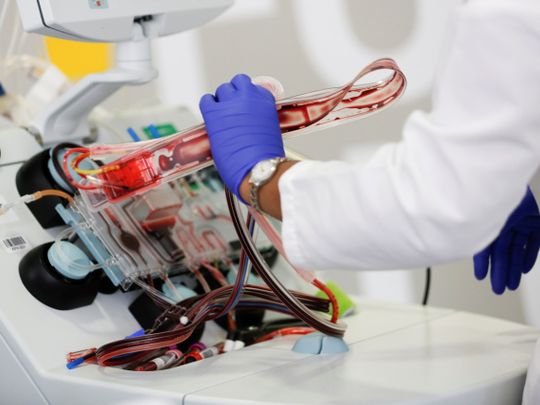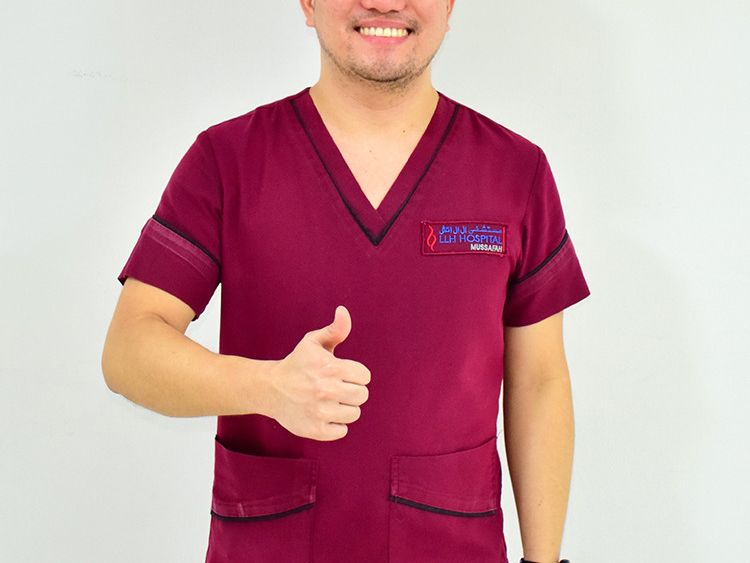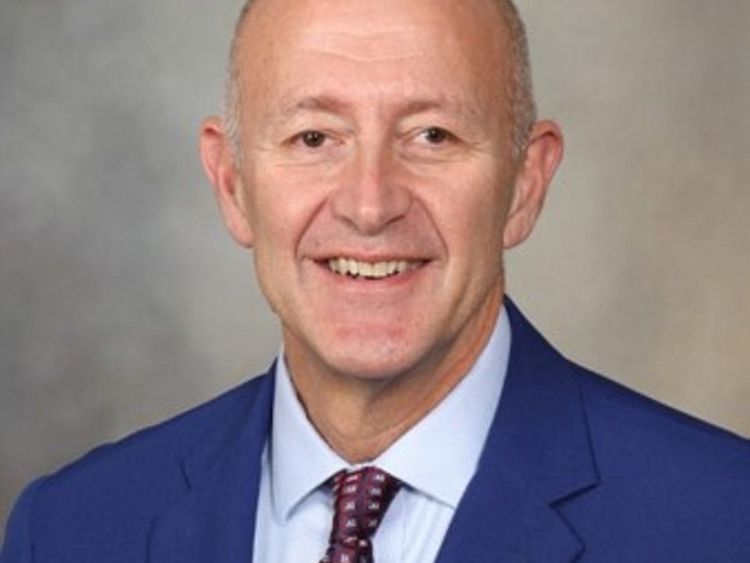From US to UAE, why Plasma Therapy gained ground in COVID-19 treatment
[ad_1]

Image Credit: Reuters
Dubai: Convalescent Plasma Therapy (CPT) has gained substantial ground in the world after providing very promising clinical results in moderate-to-severe cases of COVID-19 with comparatively less health risks. So much so, that the United States Food and Drug Administration (FDA) on August 23 issued an Emergency Use Authorisation (EUA) for CPT in cases of moderate-to-severe affliction with COVID-19.
A three-month research (between April 4-July 4) conducted by Mayo Clinic in US on hospitalised patients revealed that plasma transfusions in a cohort of 35,322 patients were associated with lower mortality. The research report entitled ‘Effect of Convalescent Plasma on Hospitalised Patients with COVID-19: Initial Three-Month Experience’ revealed that in a subset of the cohort (3,082 patients), they found lower mortality associated with plasma transfusions that contained higher levels of antibodies against the virus that causes COVID-19. The overall cohort included a diverse representation of participants by age, gender, weight, race and ethnicity.
See more
-
Dubai Metro turns 11 years old today
-
Photos: Gulf News reader shares his favourite travel destinations in the UAE, Colombia, Cuba, Mexico, New Zealand, Singapore and Australia
-
UAE-Israel peace deal signing ceremony in pictures
-
News in pictures: Amazon to hire 100,000 people, Kerala gold smuggling, Sally to hit Mexico, Russia vaccine, UAE mid-day break, Delhi COVID tests…
In the UAE, CPT was used by Rashid Hospital during the COVID-19 pandemic to treat more than 170 patients with promising results. In an interview with Gulf News, Dr Dujana Mostafa Hamad, consultant physician at Rashid Hospital’s Infectious Disease Unit and member of the DHA’s COVID-19 Research Committee, said: “To date, we have successfully transfused plasma with no transfusion-related complication to more than 170 eligible patients with moderate-to-severe COVID-19 infections and we have observed significant clinical improvement matching the international success rates with this form of therapy.”
As the world awaits an approved vaccine, CPT is increasingly being perceived as an effective method of treatment.
Dr Michael J. Joyner, MD anesthesiology from Mayo Clinic US, with special interest in blood substitutes and clinical transfusions, spoke to Gulf News to provide an insight into the CPT process:
What is CPT?
Plasma is the liquid portion of our blood and when an individual tests positive for COVID-19, his immune system produces antibodies. The high level of antibodies in the recovered patient, called Convalescent Plasma, is transfused in moderate-to-severe cases and has proven to provide significant clinical improvements in the patients, expediting recovery.
How is CPT carried out?
Our blood contains plasma, white blood cells, red blood cells and platelets. The plasma is the liquid portion of the blood that is rich in anti-bodies produced against a pathogen. So a recovered patient who donates plasma is attached to an Apheresis Machine through an Intravenous (IV) line. The Apheresis machine has a centrifuge that spins to separate all the blood components. The plasma is separated and collected while the rest of the components are transfused back into the individual with some saline to make up for the lost volume of blood.
How much Plasma is collected from one single patient at one time?
Patients donate about 600-800ml of plasma and this one donation can be used for CPT in up to three patients.
What is the shelf life of donated plasma?
Plasma is then frozen within the first 24 hours of donation and can be used up to a year.
Who is eligible to donate for CPT and when?
Potential donors must have had documented SARS-CoV-2 infection and should have tested negative to be able to donate plasma. Post the negative test, they should be symptom-free for at least 14 days.
Is any other screening required for the donor?
All other standard blood donor eligibility criteria that is normally required for any blood donor is required here. This includes they must not be suffering from any chronic or blood-related genetic disorders or infectious diseases, must be 18-65 years of age and must not weigh less than 50kg. Their blood pressure must be in the normal range (between 60/100 to 100/160mm HG). The blood group of the donor is matched with the recipient who receives the plasma for therapy. People with positive blood groups are likely to have more access to plasma whereas those with negative Rh factor will have more limited access as the donation pool for negative blood groups is going to be typically smaller.
How do we know if the donated plasma is effective?
So far, research showed that 60,000 people have been infused with plasma. Each patient is different. Some people show dramatic improvements; the rate of recovery is accelerated in many cases. Patients have been able to come out of intensive care and our research shows that a lower mortality rate is linked to those who received convalescent plasma. Our studies are still ongoing.
What are the contraindications?
A patient could suffer from an allergic reaction. Our research so far has shown less than 1 per cent contraindications, which is minimal given the efficacy of the therapy. It has so far proven to be one of the most promising therapies in conjunction with other modes of treatment.
How a male nurse from Abu Dhabi donated his blood plasma …
When Lifeline Burjeel Hospital’s Kevin Bayan, staff male nurse, recovered from COVID-19, the first thing that he wanted to do was give back to the community. So he decided to donate his plasma. As a nurse, he had been donating blood for 15 years and wanted to do something to help in the battle against COVID-19.

Image Credit: Supplied
Bayan, who worked with COVID-19 patients and was a frontline warrior at the COVID-19 ward, tested positive on April 22 after he showed typical symptoms of fever, body ache and fatigue. For the next 20 days, Bayan suffered from severe pneumonia and cough and was under treatment in the ICU.
“I suffered diarrhoea, vomiting, fever and body ache. I had lost my sense of taste and smell and I was grateful to the nurses in the ward who worked around-the-clock to care for me. I had done the same a few weeks back, but being a patient, I understood the importance of health care and the significance of donating blood plasma to help others,” said Bayan.
He remained under treatment until May 12 and was discharged after May 14. He had to go through mandatory home quarantine then for an additional 14 days before he could donate his blood plasma.
When Bayan heard about CPT, he went to donate his plasma at the Al Roudha Clinic in Abu Dhabi. “Blood plasma donation process is no different from blood donation, only in this case one is connected to a Pharesis machine and it takes longer. I was done in 30 minutes. I have heard that my blood plasma was used to treat some patients who have now recovered and I am very happy I donated for this noble cause,” said Bayan.
[ad_2]
Source link





